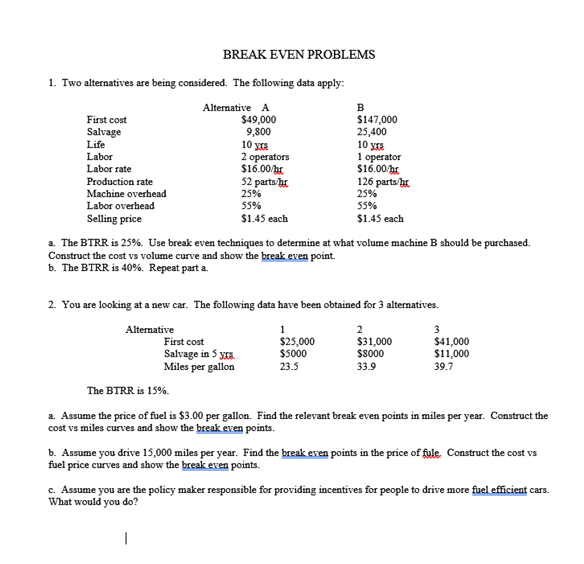
BREAK EVEN PROBLEMS 10 1. Two alternatives are being considered. The following data apply: Alternative A B First cost $49,000 $147,000 Salvage 9,800 25,400 Life 10 yrs Labor 2 operators 1 operator Labor rate $16.00/ht $16.00/ht Production rate 52 parts/ht 126 parts/hr. Machine overhead 25% 25% Labor overhead 55% 55% Selling price $1.45 each $1.45 each a. The BTRR is 25%. Use break even techniques to determine at what volume machine B should be purchased, Construct the cost vs volume curve and show the break even point. b. The BTRR is 40%. Repeat part a. 2. You are looking at a new car. The following data have been obtained for 3 alternatives. Alternative 1 2 3 First cost $25,000 $31,000 $41,000 Salvage in 5 yrs $5000 $8000 $11,000 Miles per gallon 23.5 33.9 39.7 The BTRR is 15% a. Assume the price of fuel is $3.00 per gallon. Find the relevant break even points in miles per year. Construct the cost vs miles curves and show the break even points. b. Assume you drive 15,000 miles per year. Find the break even points in the price of fule. Construct the cost vs fuel price curves and show the break even points. c. Assume you are the policy maker responsible for providing incentives for people to drive more fuel efficient cars. What would you do? 1 BREAK EVEN PROBLEMS 10 1. Two alternatives are being considered. The following data apply: Alternative A B First cost $49,000 $147,000 Salvage 9,800 25,400 Life 10 yrs Labor 2 operators 1 operator Labor rate $16.00/ht $16.00/ht Production rate 52 parts/ht 126 parts/hr. Machine overhead 25% 25% Labor overhead 55% 55% Selling price $1.45 each $1.45 each a. The BTRR is 25%. Use break even techniques to determine at what volume machine B should be purchased, Construct the cost vs volume curve and show the break even point. b. The BTRR is 40%. Repeat part a. 2. You are looking at a new car. The following data have been obtained for 3 alternatives. Alternative 1 2 3 First cost $25,000 $31,000 $41,000 Salvage in 5 yrs $5000 $8000 $11,000 Miles per gallon 23.5 33.9 39.7 The BTRR is 15% a. Assume the price of fuel is $3.00 per gallon. Find the relevant break even points in miles per year. Construct the cost vs miles curves and show the break even points. b. Assume you drive 15,000 miles per year. Find the break even points in the price of fule. Construct the cost vs fuel price curves and show the break even points. c. Assume you are the policy maker responsible for providing incentives for people to drive more fuel efficient cars. What would you do? 1







